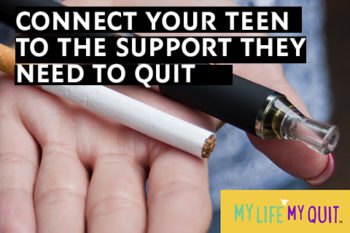As a parent, teacher, coach or youth mentor, you have an opportunity to talk to youth in a way that makes them feel heard and supported.
Here are common questions and answers about vaping for parents and adults who interact with youth.
Here are common questions and answers about vaping for parents and adults who interact with youth.
Vaping is the act of inhaling a vaporized liquid from an electronic device. The vapor commonly contains nicotine, flavoring and other chemicals. Some vape juice can contain THC, the chemical in marijuana that makes the user feel “high.”
Popular terms for vaping devices include e-cigarettes, e-cigs, smokeless cigarettes, Juul, Puff Bar, vaporizers, vape, vape pens, mods, tanks, cigalikes, e-hookah and hookah pens. These vary widely in size, shape and design. Some look like computer flash drives or highlighters, while others are bulky and box-like.
To learn more, visit Vaping 101: What You Need to Know. Head back to this page to explore flavored vape products that are popular among youth.
Vape juice or e-liquid is the liquid that is vaporized into an aerosol cloud. Vape juice most commonly contains three ingredients: propylene glycol and/or glycerin, chemicals for flavoring and nicotine.
99 percent of vape products sold in U.S. convenience stores contain nicotine, including popular products with teens. The amount of nicotine in brands like Juul, Puff Bar and Mojo can be equal to one whole pack of cigarettes.1 Some vape pods can also contain THC, the chemical in marijuana that makes the user feel “high.” Complicating the issue, vaping doesn’t give off the telltale smell of smoking marijuana or cigarettes.
Though some may claim vaping is less dangerous than traditional cigarettes, that doesn’t mean that vaping is safe. In other words, “safer” doesn’t mean safe. Studies have shown that the aerosol vapor can contain dangerous toxins, including heavy metals and chemicals known to cause cancer and other diseases.2
To create flavors, vape manufacturers mix chemicals that are harmful when inhaled, regardless of whether there’s nicotine. The chemicals can damage the heart, lungs, and immune system.3
In addition, most vape products contain nicotine, which is highly addictive. Human brain development continues far longer than was previously realized (until age 25), and nicotine use during adolescence and young adulthood has been associated with lasting brain impairments, including effects on memory and attention.4
There are hundreds of vape products on the market today, and some are owned by big tobacco companies, which have a history of prioritizing sales over safety.5
While some vapes do not contain nicotine or THC, most do. In fact, 100 percent of Puff Bar and Juul products – teens’ top choices for vaping – contain nicotine. Both of these products use nicotine salts that allow for much higher levels of nicotine compared to earlier generations of e-cigarettes.1
Plus, studies have shown that most vaping products labeled “nicotine-free” actually contain nicotine.6 For teens who don’t want to become addicted to nicotine, the safest option is not to vape at all.
Federal and state laws raised the minimum legal sales age for tobacco products, including vape, from 18 to 21. However, many young people can still get products from older peers, and age restrictions at retail stores are not always enforced.
That’s part of the problem – it can be very hard to tell. Not only do manufacturers make discreet devices that resemble flash drives, highlighters and more, but vape also does not have a strong odor that is often a giveaway for parents and teachers. Plus, many of today’s products are designed for one-time use, making them easy to dispose of and conceal.
Vaping is so discreet, in fact, that students have been known to vape during class.
…click here for a tip sheet on how to start a conversation.
 If you’re in a position to support a young person in quitting vape, My Life, My Quit is a free tobacco and vaping treatment program for Colorado youth that offers 24/7 coaching support. Youth ages 12-17 can text “Start my quit” to 36072 to connect with a coach or receive quit tips.
If you’re in a position to support a young person in quitting vape, My Life, My Quit is a free tobacco and vaping treatment program for Colorado youth that offers 24/7 coaching support. Youth ages 12-17 can text “Start my quit” to 36072 to connect with a coach or receive quit tips.